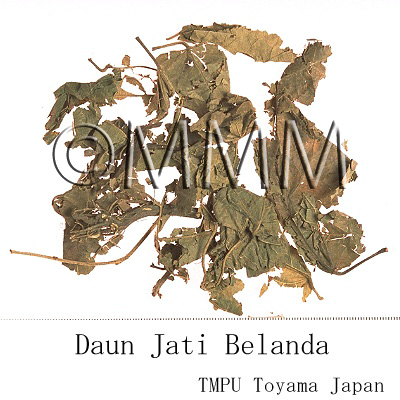Crude drug sample data base
※Click on the image to enlarge it.
Scientific information data base
| Crude drug name | Indonesian name, English name | Jati belanda | ||||
|---|---|---|---|---|---|---|
| crude drug image |
| |||||
| Original plant name | Guazuma ulmifolia Lam. var. tomentosa K. Schum. syn. Guazuma tomentosa Kunth. | |||||
| Family name | Sterculiaceae | |||||
| Used part | Leaves, seeds | |||||
| Distribution area | It is a native of tropical America. It commonly grows along roadsides in Java (Indonesia) [201]. | |||||
| Description | Leaves alternate, ovate to oblong or lanceolate, 3-21 cm x 2-6 cm, base unequally cordate, apex long-acuminate, margin serulate, basally 6-veined, scabrous above, tomentose below. The plant is a tree up to 25 m tall. Inflorescence axillary or terminal; flowers bisexual, yellow; fruit a subglobose woody capsule, many seeded [201, 220]. | |||||
| Specific actions | Astringent and carminative [201, 231]. | |||||
| Frequency in use | Moderate | |||||
| Common uses | The leaves are very popular for losing weight especially in Java, but excessive use is injurious to the bowels. An herbal tea made from leaves is used against hypercholesterolemia. Roasted seeds are boiled and the decoction is used as an astringent. The roasted seeds which are pounded by adding a small amount of water and fennel oil are used as carminative and in dyspnea. [201], [220]. | |||||
| Side effect | Fruits are edible, but will cause diarrhoea/diarrhea if eaten in excess [201]. | |||||
| Pharmacological effect | A leaf decoction intragastrically administered to temporarily hyperglycaemic rabbits showed a significant decrease of the hyperclycaemic peak and the are under the glucose tolerance curve [220]. The bark of Guazuma ulmifolia showed antisecretory activity (cholera toxin-induced chloride secretion in rabbit distal colon in an USSING chamber). Active constituents are procyanidins with a polymerisation degree of eight or higher [PMID:12570770]. Crude extract and aqueous and ethyl acetate fractions of Guazuma ulmifolia LAM. showed inhibition of bovine herpesvirus 1 and poliovirus 1 replication, also blocked the synthesis of viral antigents in infected cell cultures [PMID:16754999]. An in vitro study on the inhibition of [3]-angiotensin II binding on the human AT1 receptor by pro anthocyanidins from Guazuma ulmifolia bark found that the binding might be considered as a potentially interesting biological activity of proanthocyanidins contributing to the very broad spectrum of biological activities of the condensed tannins [PMID:12494331]. | |||||
| Medical system | Indonesian medicine (Jamu) | |||||
| Formulation | 1) Weight loss (obesity): 7 pieces of G. ulmifolia leaves, 7 pieces of Sonchus arvensis leaves, a small amount of powdered Quercus infectoria gall, are boiled or steeped with 115 ml of water. Drink 100 ml of the decoction once a day for 30 days [231]. Steepings of the leaves are drunk twice a day for one month [201]. | |||||
| References | Reference book Tips! | [201] K. Heyne, Tumbuhan Berguna Indonesia, Vols. 1-4, 1987. Diedarkan Oleh Koperasi Karyawan Departemen Kehutanan, Jakarta, Indonesia. Vol. 3, pp 1348-1349. [220] van Valkenburg, J.L.C.H. and Bunyapraphatsara, N. (editors). Plant Resources of South-East Asia No. 12 (2). Medicinal and posionous plants 2. Prosea Foundation, Bogor, Indonesia, 2002. pp 286-28. [231] Soedibyo, Mooryati: Alam Sumber Kesehatan: Manfaat dan Kegunaan (Natural resources for health. Benefits and uses). Balai Pustaka. 1998. pp 172-173. | ||||
| Research paper | 1. Felipe AM, Rincao VP, Benati FJ, Linhares RE, Galina KJ, de Toledo CE, Lopes GC, de Mello JC, Nozawa C. Antiviral Effect of Guazuma ulmifolia and Stryphnodendron adstringens on Poliovirus and Bovine Herpesvirus. Biol Pharm Bull. 29(6):1092-5, 2006. (PMID: 16754999) 2. Seigler DS.Cyanogenic glycosides and menisdaurin from Guazuma ulmifolia, Ostrya virgininana, Tiquilia plicata and Tiquilia canescens. Phytochemistry. 66(13):1567-80, 2005. (PMID: 16002108) 3. Heinrich M. Ethnobotany and natural products: the search for new molecules, new treatments of old diseases or a better understanding of indigenous cultures? Curr Top Med Chem. 3(2):141-54, 2003. (PMID: 12570770) 4. Caballero-George C, Vanderheyden PM, De Bruyne T, Shahat AA, Van den Heuvel H, Solis PN, Gupta MP, Claeys M, Pieters L, Vauquelin G, Vlietinck AJ. In vitro inhibition of [3H]-angiotensin II binding on the human AT1 receptor by proanthocyanidins from Guazuma ulmifolia bark. Planta Med. 68(12):1066-71, 2002. (PMID: 12494331) | |||||
| Remarks | The antisecretory activity of the proanthocyanidins isolated from G. ulmifolia on cholera -toxin is very interesting as epidemic cholera infections still have a high rate of fatalities [220]. In Panama, a decoction of “guacimo” bark of this plant is used in the treatment of hypertension. It has also been widen used in Latin America as stimulant for uterine contractions, for the treatment of flu, fever, gastrointestinal pain and wounds [PMID:12494331]. | |||||
| Last renewal date | 2024/03/05 | |||||





